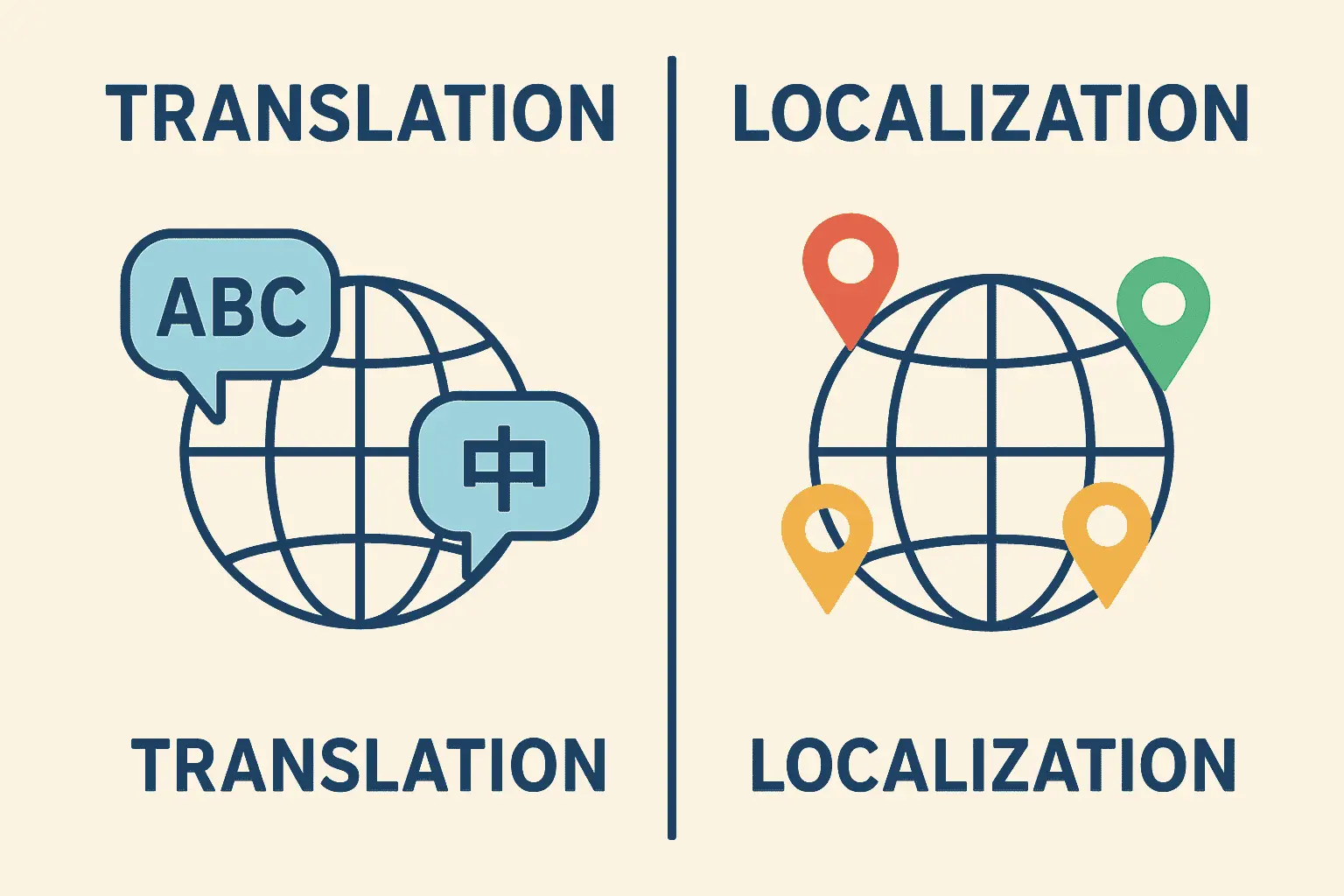In today’s global economy, the lines between translation and localization are often blurred, but they serve very different purposes. Whether you’re launching a product internationally, adapting software, or creating multilingual content, understanding the translation and localization difference can be the key to avoiding costly missteps and building a meaningful connection with diverse audiences.
Let’s explore what is translation, what is localization, how they differ, and why both matter in the digital age.
Table of Contents
ToggleWhat is Translation?
Translation is the process of converting text from one language to another while preserving its original meaning. It’s a linguistic task focused on grammar, syntax, and vocabulary. In global business, translation plays a critical role in documentation, legal contracts, user manuals, and marketing material.
For example, translating a user manual from English to Spanish is considered a translation task. The goal is to communicate the same message clearly, without changing intent. This is where human vs machine translation often comes into play; machines offer speed, but humans bring accuracy and context.
What is Localization?
Localization, on the other hand, goes beyond translation. It adapts content both linguistically and culturally for a specific audience. This is especially important in software development, where user interfaces, UX, and region-specific features must feel natural to the end user.
While translation focuses on converting text from one language to another, localization ensures the entire user experience feels natural to the target audience. A critical part of this process is Localization Testing, which helps verify that cultural nuances, functionality, and design elements work seamlessly across different markets. Without proper testing, even well-translated content can fail to engage users effectively.
Localization examples include:
- Date formats (07/29/2025 vs 29/07/2025)
- Currency (USD vs EUR)
- Measurement units (miles vs kilometers)
- Images, colors, or gestures that may carry different meanings
- Legal and compliance modifications for specific countries
In essence, cultural localization ensures your product or service resonates emotionally and functionally with your audience.
Key Differences Between Translation vs Localization
| Aspect | Translation | Localization |
| Focus | Language and meaning | Culture, context, and usability |
| Scope | Textual content | Text + visuals + formatting |
| Goal | Accuracy | Relevance and user experience |
| Tools Used | CAT tools, glossaries | i18n frameworks, localization services |
Understanding localization vs translation is vital for companies operating across borders. Without it, a message may be understood but not felt, or worse, misunderstood.
Why Translation and Localization Difference Matters in Global Business
In global business, language isn’t just a means of communication. It’s a key to trust. A great translation might still fail if it overlooks regional preferences or social sensitivities. Localization services ensure every word, image, and function speaks directly to the intended market.
A famous slogan might sound awkward or even offensive when literally translated. That’s where cultural localization becomes essential.
“If you’re speaking to everyone, you’re connecting with no one.”
Want to scale global content efficiently? Let’s Talk!
When Literal Translation Goes Wrong
We’ve all seen awkward translations on packaging, road signs, or software interfaces. Poor translations don’t just confuse users; they damage credibility and trust. That’s why exploring real-world cases in how bad translations backfired shows exactly how these mistakes could have been prevented with proper localization.
Human vs Machine Translation
Thanks to AI and Natural Language Processing (NLP), machine translation has improved drastically. Yet, it still can’t replicate cultural understanding or emotional nuance. Machine Translation in NLP and Human Translation each has its own sets of strengths and weaknesses, therefore making it very important to carefully decide which one to choose.
Localization in Software Development
In the world of software development, localization isn’t optional. It’s integral. Developers now rely on i18n (internationalization) frameworks and tools to create globally adaptable apps. React Localization and Angular Localization will help you deliver high-quality localized experiences right from the codebase and provide practical ways to make sure your product feels at home in every market from the very first release.
Testing Localization: It’s CQ, Not Just QA
Testing isn’t only about bugs. It’s about ensuring that localized content feels native. It’s important to have a Localization Testing Checklist which will help you check everything from UI elements and currency symbols to localized error messages.
Need Help with Translation and Localization Services?
Whether you’re translating technical documents, scaling content, or localizing software, we provide translation and localization services tailored to your needs.
FAQs
1. Is localization only about translating content into another language?
No. Localization goes beyond translation by adapting cultural elements like images, formats, colors, and user expectations.
2. Can machine translation handle localization effectively?
Not fully. While machine tools help with quick translation, they often lack cultural understanding. Human translation remains key for effective localization.
3. What industries benefit most from localization?
Industries like e-commerce, software development, healthcare, finance, and media rely heavily on translation and localization services to reach global users.
4. Is localization expensive?
Localization can cost more than simple translation—but the ROI is significantly higher due to better engagement and conversions.
5. How do I know if I need translation or localization?
If you’re entering a new market, you likely need localization. For internal documents or legal text, translation may be sufficient.
Check out our latest Blog Posts Below!

